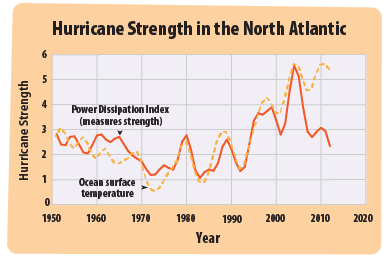Wilder Weather
 Hurricanes and other tropical storms get their energy from warm ocean water. As the top layer of the ocean gets warmer, hurricanes and other tropical storms grow stronger, with faster winds and heavier rain. Because of higher temperatures and increased evaporation, climate change causes other types of storms to get stronger, too.
Hurricanes and other tropical storms get their energy from warm ocean water. As the top layer of the ocean gets warmer, hurricanes and other tropical storms grow stronger, with faster winds and heavier rain. Because of higher temperatures and increased evaporation, climate change causes other types of storms to get stronger, too.
What's happening now?

Hurricanes in the northern half of the Atlantic Ocean have become stronger over the last few decades. This graph shows the Power Dissipation Index, which measures total hurricane power each year based on the number of hurricanes and their wind speed. The graph also shows how hurricane strength is related to water temperature. Source: EPA's Climate Change Indicators (2016).
Over the past 20 years, hurricanes and other tropical storms in the Atlantic Ocean have become stronger. Since the 1980s, the United States has also experienced more intense single-day storms that are dumping a lot more rain or snow than usual.
What will happen in the future?
As the climate gets warmer, heavier rainstorms and snowstorms (with more precipitation than normal) are expected to happen more often, and hurricanes around the world could keep getting stronger.
Why does it matter?
Hurricanes and other storms can cause flooding; damage buildings, roads, and other structures; harm crops; and put people's lives in danger.
Check out the major effects of wild weather on people and the environment:
Learn more about tropical storms by going on an expedition to the Caribbean and the Gulf of Mexico!